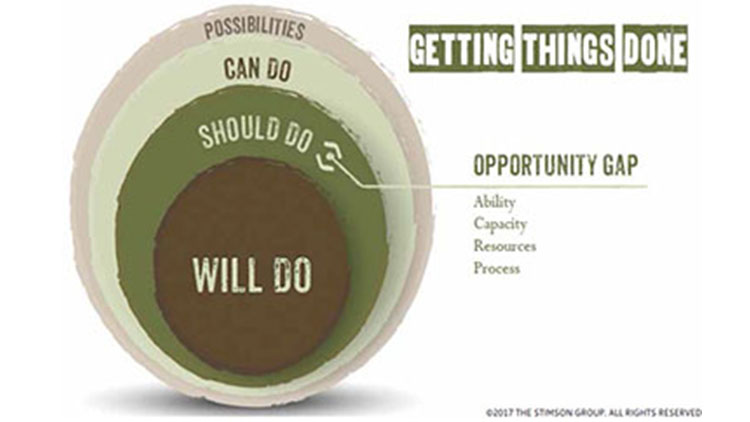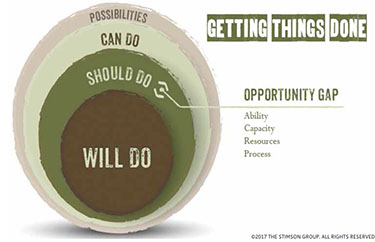Strategies for Staying on Task


If you made a list of all the ideas you know would be good for your business, where would you start? Yep, that’s my problem too. You can’t do this one yet, because that one has to happen first. You are not fully committed to this other one, but everyone says you need to do it. Some cost money you don’t think you have. No one on the team knows how to do this other one. And on and on.
My solution began at a thinking session with my marketing strategist. I pointed out that we had not done many of the things from our last session, so I felt uncomfortable coming up with more ideas. We pushed on, and by the end of our first hour I was ready to scream. My advisor was adding to the list of things I could do. The cycle was starting over. What I needed was a way to redirect the conversation that would maximize my productivity and dramatically increase my likelihood for success.
I grabbed a sheet of paper and drew four embedded circles. “I am tired of possibilities,” I said. “We keep coming up with things I ‘could do,’ but for the rest of today we are going to focus on things I will do.” Then I added words to my circles, labeling them “Can Do,” “Should Do,” and “Will Do.” I explained, “When we are done, I want to end up with a list of things I know that I have said are doable now or in the very near term. I am going to ignore the rest.”

©2017 THE STIMSON GROUP. ALL RIGHTS RESERVED
I chose one of our favorite ideas, placed it under Can Do and proclaimed, “This is a great idea that needs time, money, and skills that I don’t have.”
Next item: “This idea will help me move my business forward, is something I want to do, but isn’t important enough to act on now. This is a Should Do.”
Moving down the list: “Not only is this a good idea, it is easy to define and execute. I Will Do this.”
A daily selection of the top stories for AV integrators, resellers and consultants. Sign up below.
My intrepid strategist suggested that perhaps I needed to move more items from my Should Do list to Will Do. “Let’s reframe that statement,” I replied. “What you are suggesting is that I find ways to reduce the gap between Should and Will. Forcing items into the next level won’t work.” I called this the Opportunity Gap, and it demanded its own set of rules.
For every item on the Should Do list that has an obstacle, we will identify the task or tasks needed to overcome it. Those assignments become high-priority “Shoulds” and some moved quickly to the Will Do list.
This system only works if there is a hard line between Will and Should. The Will Do bucket is sacred and highest priority. It takes discipline to keep from dipping back into the Should bucket when you hit a wall on a Will item. The number of Will Dos is up to you, but I try to keep the list short enough to keep all the items in your head. (For me, that is about three items!) Retire completed items to make room for new ones, but not at the expense of letting anything become dormant.
One final note, don’t forget to publicly celebrate every finished item. You earned it.
Tom Stimson MBA, CTS (trstimson.com) helps owners and management teams rediscover the fun and profit that comes from making better decisions about smarter goals. He is an expert on project-based selling and a thought leader for innovative business processes. Since 2006, he has successfully advised more than 200 companies and organizations on business strategy, process, marketing, and sales.
Close the Gap Between “Should” and “Will”
In the battle to close the gap between my two lists, it became clear that I would have to create even more tasks in order to remove the obstacles for the things I could not commit to yet. The good news is that the decision tool helps me identify and maintain priorities. I learned to clarify the types of obstacles that were in play, which in turn provided more opportunities to efficiently prioritize high-value Will Do items. I found four types of obstacle—each needs a specific gap-closing technique:
Ability-based obstacles are the many things we simply don’t know how to do. Outsource an ability when you need it.
Capacity-based obstacles are rarely unsolvable (in spite of what your team might believe). To change this mindset, you need to redefine the word “busy.” Turn up the leadership knob by removing competing priorities while this task is in play.
Resource-based obstacles generally require money and institutional commitment to overcome. Enterprise software, marketing plans, and physical infrastructure are typical. Break the item down into smaller parts until you have a Will Do item that you can start.
Expectation-based obstacles are borne out of confusion or lack of clarity. We might call these half-baked ideas. If you still hear “Why are we doing this?” you may have a solution looking for a problem. If you can’t find clarity, move this item down to Could Do.
—T.S.
